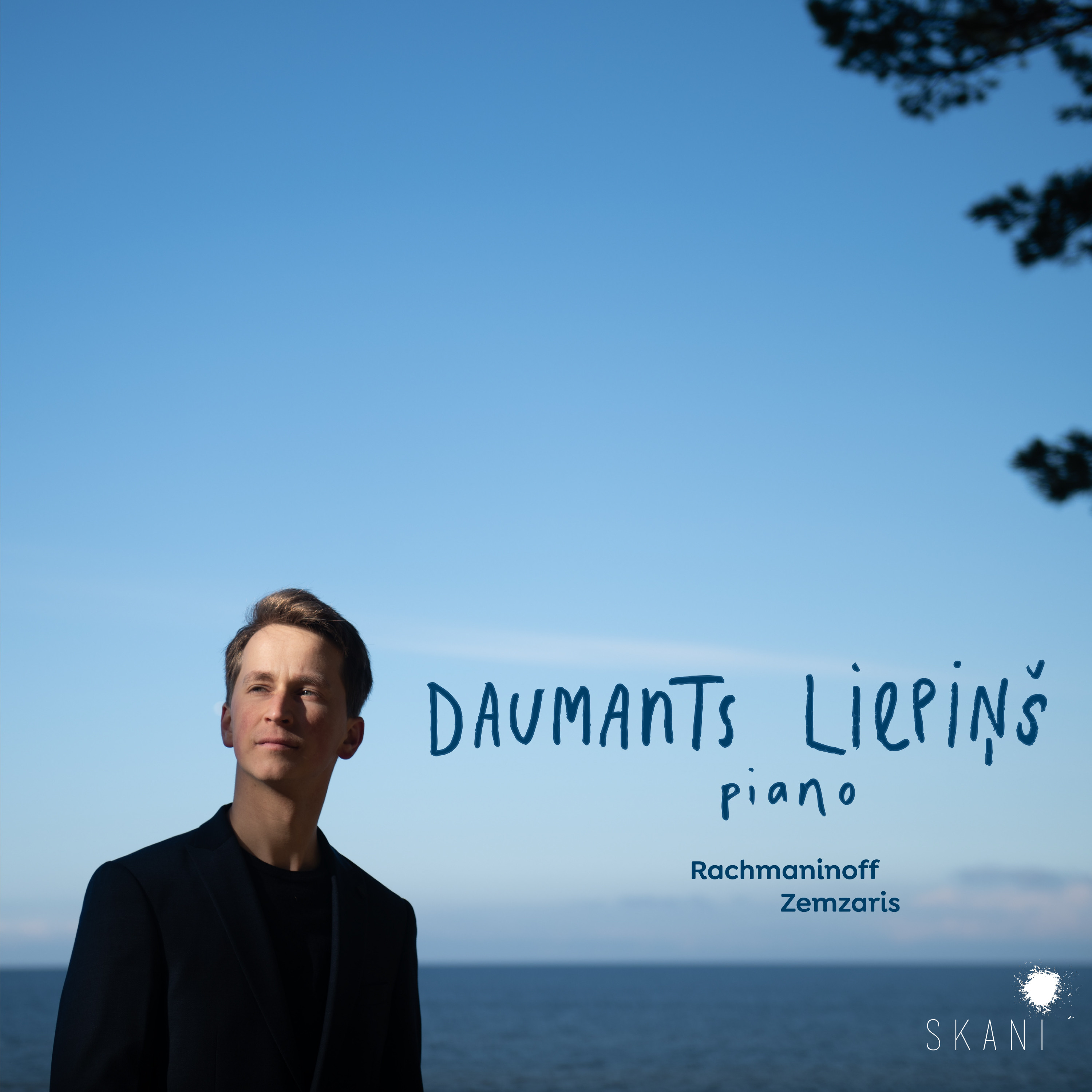"Placed at the top of Pianist magazine’s list of “Pianists to Look Out for in 2020”, the young Latvian Daumants Liepins also offers fireworks, yet they are always embedded in sustained drama. Listen to the aqueous flow and stormy waves in the second of Rachmaninov’s Op 39 Études-Tableaux, or the textural subtleties and fiery panache in the composer’s Second Sonata, dispatched in its tightened 1931 revision. Sensitive, imaginative, in full command of his instrument’s resources, Liepins effortlessly keeps the listener transfixed.
That’s equally true with the Third Sonata of Imants Zemzaris, a contemporary Latvian with a quizzical attitude towards his musical material. Restless and obsessive, this singular sonata exactly suits what Liepins describes as his recital’s theme: “the majesty of nature and the fragility of the soul”. This is a deeply satisfying album."
★★★★☆
Geoff Brown
The Times
____________________________________________________
Daumants Liepins: Exzellente Debüt-CD
Der junge lettische Pianist Daumants Liepins (*1994) sagt über seine Debüt-CD, die er dieses Jahr aufgenommen hat: « Wie viele von uns habe auch ich während der Pandemie mehr Zeit in der Natur verbracht. Ähnlich wie Imants Zemzaris und Konstantin Treplyov (Hauptfigur in Chekhovs Die Möwe, An. Der Red.) dachte ich auf meinen langen Spaziergängen in der Nähe meiner Wohnung viel über die Aufgabe der Kunst in der Welt nach, ich hörte die Rufe der Möwen vor dem Hintergrund des Meeres und ich spürte wirklich die Macht des Elements Wasser, genau wie in der Musik Rachmaninovs. Und genau darum geht es in diesem Album, um die Majestät der Natur und die Zerbrechlichkeit der Seele ».
Daumants Liepins’ erste CD beinhaltet u.a. die Ersteinspielung der 3. Sonate, ‘Möwe’, von Imants Zemzaris, die sich auf das gleichnamige Drama von Anton Chekhov bezieht.
Das Stück spielt um 1895 im zaristischen Russland. Der junge Konstantin Treplyov, möchte Schriftsteller werden und hat ein kleines Theaterstück geschrieben, welches bei einem Gesellschaftsabend aufgeführt werden soll. Die Hauptrolle spielt seine Geliebte Nina. Doch Treplyov wird dabei nicht nur, wie üblich, von seiner Mutter kritisiert, sondern verliert auch noch Nina an einen erfolgreichen Schriftsteller. Sie wird zwar Jahre später zu ihm zurückkehren, aber nicht um zu bleiben, woraufhin sich Treplyov erschießt.
Der erste Satz der Sonate beginnt wie ein morgendliches Naturbild, frisch und lieblich, doch im Andantino wird die Musik nebliger, unentschlossen, suchend, stellenweise auch zärtlich und sehnsuchtsvoll. Das Moderato ist neoklassisch und verspielt, eine Art Menuett, das einzelne dunkle Akkorde bedrängen. Die Musik wird dann immer schräger, rhythmisch verwirrend und insgesamt verstörend, obwohl das verspielte Anfangsthema immer wieder versucht, durchzubrechen, aber von dunklen Kräften daran gehindert wird. Das abschließende Andante beginnt mit einem Hammerschlag und entwickelt sich zunächst düster wie das Schicksal des jungen Schriftstellers, wird aber dann zunehmend dramatischer und endet illusionslos.
Zu dieser bereichernden Musik führt eine sehr nachdenkliche und verträumte Interpretation der zweiten der Etudes-Tableaux op. 39 von Rachmaninov, dessen Zweite Klaviersonate das auf einem guten Flügel sehr gut aufgenommene Programm beschließt. Das Allegro agitato spielt Liepins nicht aufgeregt, sondern mit perfektem Atem, wodurch das Auf und Ab der Gefühle besonders gut zum Ausdruck kommt.
Sehr gut gelingt ihm auch der zweite Satz mit seinem Wechsel von dunkler Turbulenz sowie purer Reinheit. Das Finale bekommt die nötige Leidenschaft und endet mit einem fast ekstatischen Triumph des Lichts.
The young Latvian pianist Daumants Liepins (*1994) says of his debut CD which he recorded this year: « Like many of us, I also spent more time out in nature during the pandemic. Similarly to Imants Zemzaris and Konstantin Treplyov, on my long walks near my home I thought a lot about art’s mission in the world, I listened to the calls of the seagulls against the backdrop of the sea, and I truly felt the might of the element of water, just like in Rachmaninov’s music. And that is what this album is about about the majesty of nature and the fragility of the soul. »
Liepins’ first CD includes the premiere recording of the Third Sonata, ‘Seagull’ by Imants Zemzaris, which refers to the drama of the same name by Anton Chekhov.
The piece is set in czarist Russia around 1895. The young writer Konstantin Treplyov wrote a small play which is to be performed at a party. The leading role is played by his lover Nina. But Treplyov is not only criticised by his mother, as usual, but also loses Nina to a successful writer. She will return years later, but not to stay, whereupon Treplyov shoots himself.
The first movement of the sonata begins like a morning picture of nature, fresh and lovely, but in the Andantino it becomes misty, indecisive, searching, at times tender and yearning. The Moderato is neoclassical and playful, a kind of minuet that individual dark chords try to disturb. The music then becomes more and more oblique, rhythmically confusing and generally disturbing, although the playful opening theme always tries to break through but is prevented from doing so by dark forces. The concluding Andante begins with a hammer blow and at first develops darkly like the fate of the young writer, but then becomes increasingly dramatic and ends without illusion.
Before this rewarding piece there is a very thoughtful and dreamy interpretation of the second of the Etudes-tableaux op. 39 by Rachmaninov, whose Second Piano Sonata concludes the programme. Liepins plays the Allegro agitato not excitedly, but with perfect breath, thus very well expressing the ups and downs of the emotions. His performance of the second movement perfectly underlines the alternation of dark turbulence and purity. The finale gets the necessary passion and ends with an almost ecstatic triumph of light.
Remy Franck
pizzicato.lu
___________________________________________________
"The debut disc from the 26-year-old Latvian pianist Daumants Liepiņš (Skani), a rising star and distinguished prize-winner, is also an eloquent product of its time. The recital was prompted by lockdown walks on the Baltic coast and the cries of sea birds. As well as Rachmaninov’s Sonata No 2, his Étude-Tableau, Op 39 No 2 is paired with the Piano Sonata No 3 “Kaija” (Seagull) by Imants Zemzaris (b.1951). These last two both conjure the flight of seagulls."
Fiona Maddocks
The Guardian
____________________________________________________
"Imants Zemzaris 2008. gadā komponē Trešo klaviersonāti “Kaija” un trīs gadus vēlāk arī pirmatskaņo. Sergejs Rahmaņinovs 1913. gadā komponē Otro sonāti, un saviem darbiem viņš, protams, ir pirmatskaņotājs. Daumants Liepiņš 2020. gadā abas sonātes ietver vienā albumā, klāt vēl pieliekot Rahmaņinova Otro etīdi gleznu no 39. opusa, un tas darīts ar radošu pārliecību un spilgtu intuīciju. Protams, šādā salikumā klātesošs ir arī trešais meistars – Antons Čehovs, taču mākslinieciskās metaforas šeit sniedzas daudz tālāk par vienkāršu mūzikas un literatūras saskarsmi. Kaut vai tādēļ vien, ka Zemzara sonātē nekas nav pašsaprotams un sākuma liriskās noskaņas un nostalģiskie tēli aizved aizvien dziļāk psiholoģiskā introspekcijā. Un ar Rahmaņinova
romantiski aizrautīgo vēstījumu patiesībā ir līdzīgi, skaņuraksta intonāciju un harmoniju rakursiem it īpaši Otrajā sonātē dažbrīd sasaucoties ar Aleksandru Skrjabinu. Turpretī Daumants Liepiņš sevišķi saista ar kādu pat visizcilākajiem pianistiem reti sastopamu īpašību – spēju apvienot romantisku intensitāti un emocionālu piepildījumu ar padziļinātu cieņu pret skaņu, pret skanējumu, pret komponista radītās mūzikas būtības autentiskumu. Un rezultātā tapušas tik vērtīgas interpretācijas, ka jau tagad gaidu turpinājumu – piemēram, Skrjabinu kopā ar Pēteri Vasku vai Šostakoviču kopā ar Andri Dzenīti. Un jā – Daumants Liepiņš spēj kaut nedaudz līdzēt tajā, ka tik ļoti pietrūkst Čehova “Kaijas”. Un “Trīs māsu”. Un ne jau tikai viņu."
Ideja ***** Atskaņojums ***** Baudījums *****
Armands Znotiņš, "Mūzikas Saule" Nr. 4/2020
____________________________________________________
"LMIC izdevis pianista Daumanta Liepiņa debijas albumu, kas kādu laiku kalpos kā vizītkarte centienos iekarot plašāku klausītāju loku arī ārpus dzimtenes. Vai šī vizītkarte izraisīs interesi? Jau 1890. gadā Antons Rubinšteins konstatēja: “Mūsu dienās diemžēl pārāk daudzi labi spēlē klavieres.” Tirgus pārpildīts, un jābūt tiešām spēcīgiem argumentiem, lai sev pievērstu uzmanību. Viena no šādām iespējām ir iekļaut tādu mūziku, ko citi nav ieskaņojuši. Pasaulē joprojām ir visai daudz šādu interesentu un viņus noteikti iepriecinās Imanta Zemzara Trešā sonāte “Kaija”. Zemzaris ārpus Latvijas ir pilnīgi nepazīstams, un arī Latvijā maz ko zina par viņa veikumu. Gatavojot šo rakstu, izstudēju Zemzara kompozīciju sarakstu un biju pārsteigts, cik daudz darbu sarakstīts. Klaviermūzikā man viņš asociējas ar jaunības gadu šedevriem “Varšavas triptihu” un “Faktūrām”, kas lika pamatus latviešu minimālismam. Tomēr Trešo sonāti (2008) raksturo plaša forma (>25 min.), kas arī ir, manuprāt, tās galvenais trūkums, jo spožu ideju netrūkst. Komponistam te būtu jārīkojas kā otrajam albuma autoram Sergejam Rahmaņinovam, kurš radikāli saīsināja savu Otro sonāti. Tas attiektos uz II–IV daļu. Pianistiskā faktūra tipiski latviska, proti, ar īpašu izdomu neizceļas, kas sevišķi saklausāms kontekstā ar krievu komponistu, tāpēc apšaubu pianistu interesi par šo kompozīciju vismaz tās pašreizējā veidolā. Rahmaņinovu pārstāv viņa “Etīde glezna” op. 39/2. Ja pats sākums būtu dinamiski klusāks (s. c., komponists nav sniedzis dinamisku norādi!), it kā nedaudz aizmiglots, tad šīs visplašākās gleznas iztulkojumu varētu vērtēt kā lielisku. Bet centrālais darbs ir Otrā sonāte tās otrajā redakcijā (MS 2014. g. 4. laidienā iztirzāju Vestarda Šimkus veikumu – viņš gan bija izvēlējies praktiski nekad neieskaņoto pirmo redakciju). Nu divi latvieši pievērsušies šim pianistu repertuārā tik populārajam darbam. Te Daumants Liepiņš apliecina īstu meistarību, veidojot dramaturģisko līniju. Noteikti jāpiestrādā pie izteiksmīguma piano dinamikā un tembrālajām krāsām. Lento nenozīmē pulsācijas izzušanu – te vecākais kolēģis krietni pārāks. Izdevuma vājā puse – neizteiksmīgs grafiskais noformējums. Ināras Jakubones plašā literāri atraktīvā eseja nesniedz praktiski nekādu informāciju nedz par Zemzari, nedz pianistu. Labākajās famīlijās klavieru ieskaņojumos norāda instrumenta marku un meistaru, kas to sagatavojis ierakstam. Veiksmīga debija."
Ideja ***** Atskaņojums **** Baudījums ***-****
Juris Griņevičs, "Mūzikas Saule" Nr. 4/2020

